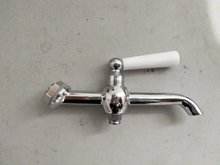How to maintain the lead damage method of the faucet
Maintenance of faucets to reduce lead damage Method 1: Knowledge in water connection to ensure healthy drinking water
For how to maintain the faucet and reduce lead contamination, experts suggest that when turning on the faucet every morning, you can first empty it for a while, then fill it with water and use it to flush the bathroom, mop the floor, etc. Due to the fact that the water just turned on the faucet often contains more harmful substances, such as more lead. A faucet that has been out for a long time and has not been turned on for a long time cannot be immediately connected to water for drinking after returning.
Method 2 for reducing lead damage during faucet maintenance: The longer the time, the more lead will be released and replaced regularly
Regularly replacing faucets is also one of the ways to reduce lead damage to faucets. Nowadays, chlorine is often used as a disinfectant in tap water, and residual chloride compounds in the water can exacerbate the separation of lead elements from the faucet. Generally speaking, if copper alloy faucets are used for more than 5 years, the amount of lead released will greatly increase. Therefore, it is not advisable to use faucets at home for too long. We must remember this basic safety knowledge.
Maintenance of faucets to reduce lead damage Method 3: Diligently sorting and removing impurities from the sieve
If after using it for a period of time, it is found that the water output decreases, and even the water heater stalls, it may be due to water and sand blocking the screen. At this point, quietly unscrew the sieve cover at the outlet of the faucet and remove impurities. Generally speaking, regularly cleaning the impurities in the sieve, up to once every three months, plays a very important role in water quality and home safety.

Method 4 for reducing lead damage during faucet maintenance: Cleaning the faucet and maintaining the outer coating
After prolonged use, the coating on the faucet will oxidize, thereby accelerating the release of lead. When cleaning and maintaining the faucet, we should use a soft cotton cloth that has been wrung out to scrub. Do not use a damp towel to directly scrub to avoid leaving scale, and do not use items with burrs to scrub and damage the coating. To avoid letting the faucet come into contact with acidic or alkaline liquids, you can spray a neutral cleaning agent on a soft cloth and quietly scrub the faucet.
Method 5 for Maintaining and Reducing Lead Damage to Faucets: Avoid Aging of Coating and Use Protein Safely
The shiny surface of a faucet is mostly due to a layer of gold plating on the outside. The gold-plated part is easily peeled off and loses its luster, and can also be oxidized and corroded over time. Protein can be used to maintain the luster of the coating. Beat the protein with an egg beater until it slightly bubbles, then clean the faucet with warm water and wipe it dry. Dip in a small amount of protein and quietly wipe the gold-plated part to maintain the luster of the coating.
Reminder, the faucet is the last checkpoint for tap water to enter residential households, and there is a possibility of bacterial contamination during transportation. If the faucet brings new lead damage, how unsafe would it be for us to drink such water? Therefore, in daily life, we must understand the safety knowledge of faucet cleaning and maintenance to reduce lead damage in tap water.
Article source: Kaiping water heater faucet& Nbsp& Nbsp& Nbsp& Nbsp; http://www.kplongyi.com/
-
12-06
Manufacturer of water heater: Maintenance methods for water heaters
Maintenance methods for water heatersA water boiler is a type of drinking water equipment that uses electricity or gas to produce boiled water. The machine is easy to operate, has a beautiful appearan
-
11-11
Water heater manufacturer: advantages of stepper electric water heaters
The advantages of stepper electric water heatersMany people are currently quite familiar with electric water heaters, and we can see their traces in many places such as enterprises, factories, schools
-
10-14
Is the "high flux" water purifier really good
Looking at the water purification market in the past two years, high-frequency words are undoubtedly "high flux". Haofan Water Purification Enterprise regards "high flux non tank pure water machine" a
-
02-19
What is the possibility that the faucet of the water heater cannot discharge water?
1. It may be due to poor contact of the water level wire, with the plug on the circuit board under the machine and unplugged from the beginning (the overflow water flow is large, which is the problem)

